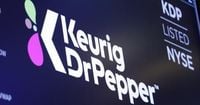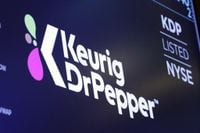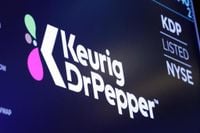In a move set to reshape the global beverage landscape, Keurig Dr Pepper announced on August 25, 2025, that it will acquire JDE Peet’s—the Amsterdam-based owner of Peet’s Coffee and several other prominent brands—in a deal valued at $18 billion (15.7 billion euros). This acquisition, one of the largest in the sector in recent years, will unwind the 2018 merger between Keurig and Dr Pepper, splitting the company into two focused giants: one for coffee and one for cold beverages like Snapple, Dr Pepper, 7UP, and energy drinks.
The deal, which is expected to close in the first half of 2026, marks a dramatic shift in strategy for Keurig Dr Pepper. Just seven years ago, the company was heralding the benefits of its merger; now, it’s betting that sharper focus and tailored strategies will unlock more value for shareholders. CEO Tim Cofer called it a “transformational moment” for the beverage sector, stating in prepared remarks, “By creating two sharply focused beverage companies with attractive and tailored growth propositions and capital allocation strategies, we are poised to generate significant shareholder value in both the near and long term.”
JDE Peet’s, the target of the acquisition, is no small player. Based in Amsterdam, the company owns an impressive portfolio of brands including L’OR, Jacobs, Douwe Egberts, Kenco, Pilao, OldTown, Super, and Moccona, in addition to Peet’s Coffee. This broadens Keurig’s reach far beyond its traditional stronghold in North America, giving the soon-to-be independent coffee company a truly global platform. According to CEO Cofer, “We like, and I like, the coffee category. Why? It’s huge. It’s ubiquitous. Obviously, we’ve up to this point focused on North America. But the global data shows coffee is consistently growing on a volume basis above population.”
The numbers behind the split are striking. The coffee business is expected to generate $16 billion in annual sales, with roughly 40% coming from North America, another 40% from Europe, and 20% from emerging markets. The cold beverage company, meanwhile, will bring in about $11 billion in annual sales in the U.S. and Mexico, with a focus on both legacy brands and newer, faster-growing products like the energy drinks Ghost and C4 and the hydration drink Electrolit.
Leadership for the two new companies has already been mapped out. Tim Cofer will become CEO of the cold beverage business, which will be headquartered in Frisco, Texas. Sudhanshu Priyadarshi, currently Keurig Dr Pepper’s chief financial officer, will lead the coffee business from Burlington, Massachusetts, with international operations managed out of Amsterdam.
The announcement sent immediate ripples through the market. Shares of Keurig Dr Pepper fell 9% before the opening bell and dropped as much as 11% in afternoon trading on August 25, as investors digested the news and expressed concerns over the company’s plan to finance the acquisition with a mix of cash and debt. S&P Global responded by placing Keurig Dr Pepper on a credit watch with negative implications, citing worries about the increased debt burden and the complexity of the two-step transaction.
Cofer, for his part, sought to reassure investors and analysts during a conference call, emphasizing that the split would allow each business to be more nimble and better able to pursue growth in its respective market. “Following the separation, each stand-alone entity will lead its industry with a sharp strategic focus and with operating models that are finely calibrated to their unique categories and markets,” he said. The companies also project that the combined buying power will help the coffee business compete more effectively with global giants like Nestlé and Starbucks, especially as coffee prices rise due to surging demand and poor weather conditions.
But the timing of the acquisition introduces its own set of challenges. In the summer of 2025, President Donald Trump imposed a 50% tariff on most imports from Brazil—the world’s leading coffee producer—as part of an investigation into former Brazilian president Jair Bolsonaro, a Trump ally. Cofer acknowledged during a July investor call that the impact of these tariffs would be “more prominent” in the second half of the year, potentially squeezing margins just as the company embarks on its ambitious new chapter.
Meanwhile, shifting consumer preferences have put pressure on traditional soft drink sales. Health-conscious consumers are increasingly turning to alternatives, prompting beverage companies to pivot toward growth areas such as energy drinks and functional beverages. Keurig Dr Pepper’s beverage business will continue this trend, leveraging its $11 billion in annual sales to invest in brands and products that resonate with today’s consumers. Notably, the company has recently acquired Dyla, a maker of powdered drink mixes and water enhancers, and its rival PepsiCo snapped up the prebiotic soda brand Poppi in March 2025.
The merger is expected to yield approximately $400 million in savings over three years, according to statements from both companies. These efficiencies, they argue, are critical to maintaining competitiveness in a sector where scale, agility, and the ability to adapt to changing tastes are more important than ever. The deal also reflects broader trends in the food and beverage industry, with major players like Kellogg Co., Mars, Ferrero, and Kraft Heinz all undertaking significant structural changes or acquisitions in the past two years to keep pace with evolving consumer demands.
For Keurig Dr Pepper, the decision to split is as much about the future as it is about the present. The company hopes that by separating coffee and cold beverages into distinct entities, each can pursue growth strategies tailored to their unique markets—whether that means expanding globally, investing in innovation, or responding to regional consumer trends. As Cofer put it, “The global data shows coffee is consistently growing on a volume basis above population.”
Yet, uncertainty remains. The company’s stock took a hit, and credit agencies are watching closely. Investors are wary of the debt load and the complexity of executing a deal of this magnitude. The impact of U.S. tariffs on Brazilian coffee imports looms large, threatening to raise costs just as the new coffee business is getting off the ground. And as the food and beverage industry continues to evolve, the newly independent companies will face stiff competition from both established giants and nimble upstarts.
Still, Keurig Dr Pepper’s bold move signals its intent to shape the future of beverages—one cup, and one bottle, at a time.



